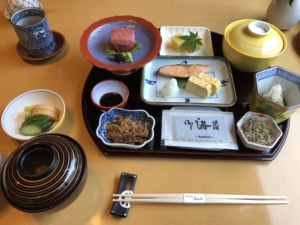“Have Fun in Japan!” Getting Yourself Ready to Work for 3 Days in Another Timezone (without actually going there)
This post isn’t about how to run training in Japan, it’s about how to get your body ready to do training in Japan, if you live 7 time zones away in Switzerland.
Normally, I would be enjoying a Bento box right now in Tokyo, preparing with my Japanese co-trainer, the interpretation team, and colleagues there for 3 full days of facilitation training for a large group of local facilitators and change agents.
I’m still doing that, at least most of it, except I’m eating muesli, it’s 3:30am and I’m still in Geneva.
For the last few years, I’ve had the great pleasure to join Change Agent Inc. to deliver a Foundations of Facilitation training programme in Japan. This year, as with many other programmes affected by Covid-19, we are taking the training into virtual space. All the preparations are going well, the content is tight, and we are all now seasoned at online delivery from a technical standpoint. But biological? I will be delivering training for 8 hours a day, from 2:30am-10:30am, for 3 days. This is not a one-off 90-minute webinar in JST – this takes more thorough preparation to get body and mind ready for this.
“Have fun in Japan!”
That’s what my husband said to me last night at 7pm as I walked down the stairs to the basement bedroom, arms laden with clothes, pillows, and cables. Not quite the expertly packed samsonite that I would have been taking on a long-haul JAL flight to Narita. At least I can pop back for my forgotten toothbrush in 2 minutes. By 7:30pm I would be asleep.
Now at 3:30am I am up and at my desk. This is Day 4 of my preparation to be on Japan time by Wednesday. I have 2 more days to get to the point where I am asleep by 5:30pm and up at 1:30am and ready for work by 2am for last minute tech and sound check, with a “go live” at 2:30am.
I have been following this schedule, which I planned weeks in advance, to gradually shift my normal 10pm sleep time up, and retain an 8-hour sleep window each night as much as possible:
- Starting point: 10pm sleep – 6am awake
- Day 1: 9pm sleep – 5am awake
- Day 2: 8pm sleep – 4am awake
- Day 3: 8pm sleep – 4am awake
- Day 4: 7:30pm sleep – 3:30am awake
- Day 5: 6pm sleep – 2am awake
- Day 6: Ending point: 5:30pm sleep – 1:30am awake
- Repeat for Training for 3 days
So far on Day 4 I am on track, and although I am still a big foggy in those early hours, it wasn’t that hard to get to sleep and get up early as the change has been gradual. The house is quiet and a little creepy at this time of night and I have to be careful not to make noise and wake up others. In a reflective moment, just me and the other noctural animals, here are a few observations:
After Day 3, your hours are anti-social. The alarm wakes others up and moving around to get dressed is bothersome. Others will also wake you up when they go to bed later, which can affect your sleep. So, at this point, you will need to move to another room in the house, if you can, if you are co-habitating.
“Jet lag” will present itself in other ways. You will eat breakfast in the middle of the night and have lunch when people are having breakfast, and dinner will be at the time of a mid-afternoon snack. That will be weird, and you won’t be very hungry at those odd times. But you need to eat or else you will be starving at midnight and that will wake you up. You also can’t rely on the sunshine to get your body on track as you would if you were onsite – try to go outdoors when you can as soon as it is light, and have a good dark room with blackout blinds for sleep if needed.
Your periods of overlap with others IRL will reduce dramatically. No evening television, no family meals for a few nights. You’re basically gone if others go off to work or school during the day. Just as though you got on that plane. You need to make arrangements for others to take over things that you might normally do in the evening. Tell friends who call and text you regularly in the evening that you won’t be available as normal.
Protect the rest of your day. It is tempting to take on additional meetings or work during the “regular” workday after your training ends at 10am. You could effectively be working every minute of your waking hours if you are not careful. A meeting from noon to 2pm after your training seems perfectly logical and you have that time free in your calendar, right? But you have to remember that you will have just worked a 10-hour day, and that will be like scheduling every waking moment. I guarantee that this is hard to explain to colleagues who wonder why you can’t join their meeting even though you are done with your training and not yet sleeping, and it’s only 4pm.
Take it seriously. It is pretty easy to let things slide and default to normal in the run up to your workshops, but the result could be a zombie on the training team sitting on the other side of the video camera that makes little sense in English and even less when translated into Japanese. This is part of the preparation stage of facilitation and training processes, so needs to be built into your schedule, recorded in your agenda, with all alarms set and followed.
I’m excited about the training course, it will be enormously fun and full of learning. I am a little more nervous about this biological part as this is the first time I have had to get my European body on to Japan time without physically moving it, and I want to do this in a mindful and structured way. Maybe tomorrow when I get up at 2am, I will start thinking about how to reverse my schedule to get me back on to Central European Time at the end of it all…







Fascinating story Gillian
Hope the workshop has gone well and that reentry goes smoothly
Dear Gillian, your experience and generosity explaining it is amazing. Please tell us how it ended ?
Thank you, Sarah! The re-entry has been going well, and took a less measured path! Nearly there…
Dear Cuauhtemoc, Thanks for your kind message! It went very well – the long days worked fine. Our assumptions are that people won’t spend a full day online, but if it is highly engaging, and the breaks are generous and you are completely in your own timezone, it is possible to take a 3-day F2F workshop design and pivot it into online delivery. It takes lots of preparation, both in terms of the technical aspects as well as interpretation in this case. But it went pretty smoothly and was a great learning experience all around!
thanks for your reply!